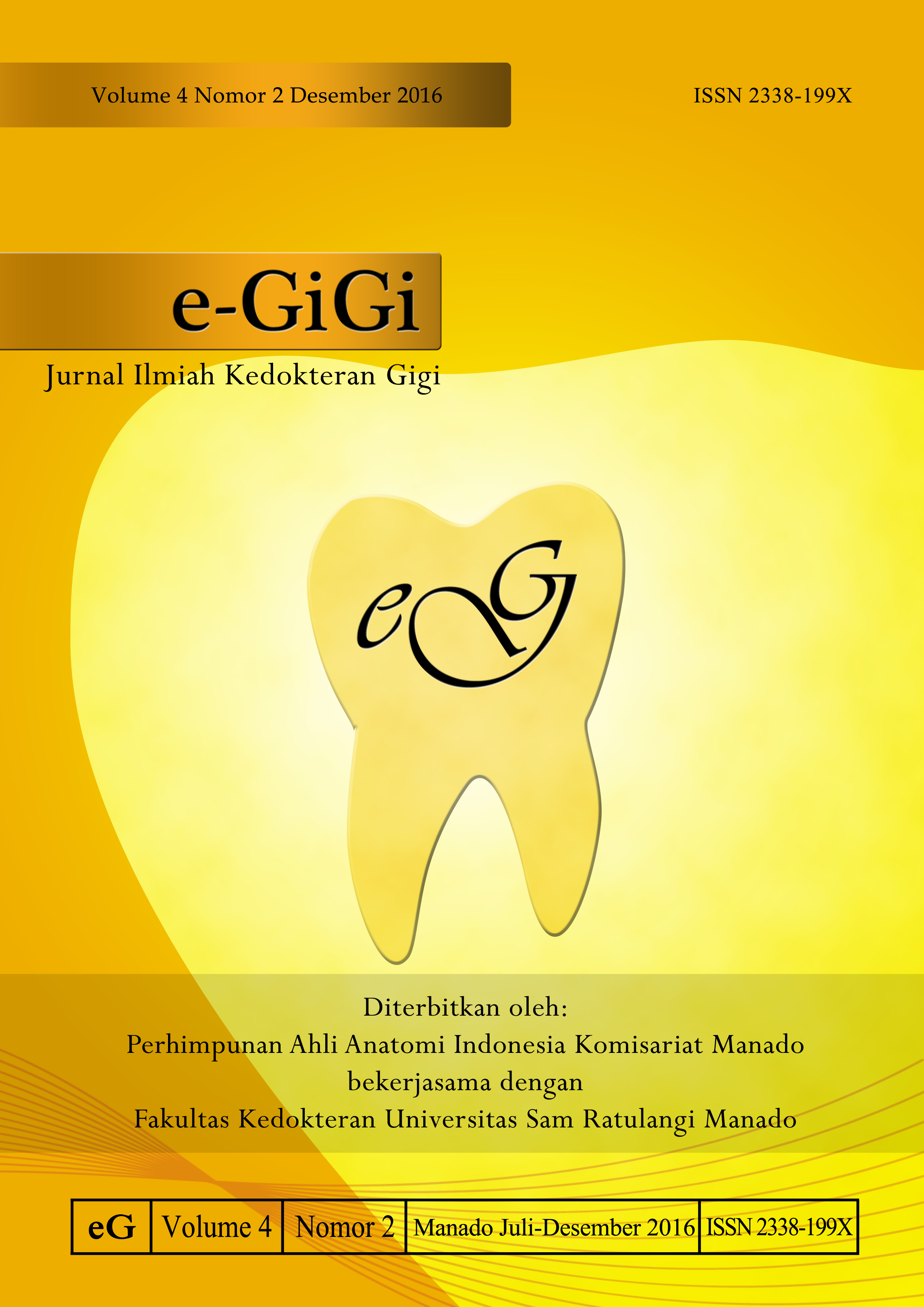Perbandingan efektivitas pendidikan kesehatan gigi menggunakan media video dan flip chart terhadap peningkatan pengetahuan kesehatan gigi dan mulut anak
DOI:
https://doi.org/10.35790/eg.4.2.2016.13490Abstract
Abstract: Currently, the oral health of children in Indonesia is still a problem dominated by caries and periodontal disease. A highly influential factor to these two diseases is behavior. One way to change that behavior is by intervening through education to improve children knowledge by using media or tools. This study aimed to compare the effectiveness of dental health education using video media and flip chart in increasing children knowledge about oral health. This was a quasi experiment with a non equivalent control group design. Samples were students of SDN Kolongan aged 10-11 years old obtained by using total sampling method and were divided into two treatment groups: video media and flip chart. This study used the Mann-Whitney hypothesis test with a confidence level of 95% (p<0.05). The results showed that the p-value of dental health education influence using video media and flip chart to the improvement of oral health knowledge of children was 0.000 for each media. The statistical test comparing the effectiveness of dental health education using both media showed a p-value of 0.007. Conclusion: Dental health education using video and flip chart media improved effectively the oral health knowledge of students. Moreover, dental health education using video media was more effective in improving the oral health knowledge of students than using flip chart media.
Keywords: dental health education, video media, flip chart media, children knowledge
Abstrak: Saat ini kesehatan gigi dan mulut anak di Indonesia masih menjadi masalah yang didominasi oleh penyakit karies gigi serta periodontal. Faktor yang sangat bepengaruh pada kedua penyakit ini yaitu faktor perilaku. Salah satu cara untuk merubah perilaku yakni dengan melakukan intervensi lewat pendidikan untuk meningkatkan pengetahuan anak. Pemberian pendidikan kesehatan gigi dan mulut (PKG) pada anak akan lebih efektif dan optimal bila menggunakan media atau alat bantu. Penelitian ini bertujuan untuk mengetahui perbandingan efektivitas PKG menggunakan media video dan flip chart terhadap peningkatan pengetahuan kesehatan gigi dan mulut anak. Jenis penelitian ialah quasi experiment dengan rancangan non equivalent control group. Sampel yaitu siswa SDN Kolongan yang berusia 10-11 tahun. Teknik pengambilan sampel menggunakan metode total sampling. Sampel dibagi menjadi dua kelompok perlakuan yaitu kelompok yang menggunakan media video dan kelompok yang menggunakan media flip chart. Penelitian ini menggunakan uji hipotesis Mann-Whitney dengan tingkat kepercayaan 95% (p<0,05). Hasil penelitian menunjukkan bahwa PKG menggunakan media video dan flip chart terhadap peningkatan pengetahuan kesehatan gigi dan mulut anak masing-masing dengan nilai p=0,000. Hasil uji statistik perbandingan efektivitas PKG dengan menggunakan kedua media tersebut mendapatkan nilai p= 0,007. Simpulan: PKG menggunakan media video dan flip chart efektif terhadap peningkatan pengetahuan kesehatan gigi dan mulut anak. PKG menggunakan media video lebih efektif dalam meningkatkan pengetahuan kesehatan gigi dan mulut anak dibandingkan menggunakan media flip chart.
Kata kunci: PKG, media video, media flip chart, pengetahuan anak
Downloads
How to Cite
Issue
Section
License
COPYRIGHT
Authors who publish with this journal agree to the following terms:
Authors hold their copyright and grant this journal the privilege of first publication, with the work simultaneously licensed under a Creative Commons Attribution License that permits others to impart the work with an acknowledgment of the work's origin and initial publication by this journal.
Authors can enter into separate or additional contractual arrangements for the non-exclusive distribution of the journal's published version of the work (for example, post it to an institutional repository or publish it in a book), with an acknowledgment of its underlying publication in this journal.
Authors are permitted and encouraged to post their work online (for example, in institutional repositories or on their website) as it can lead to productive exchanges, as well as earlier and greater citation of the published work (See The Effect of Open Access).






